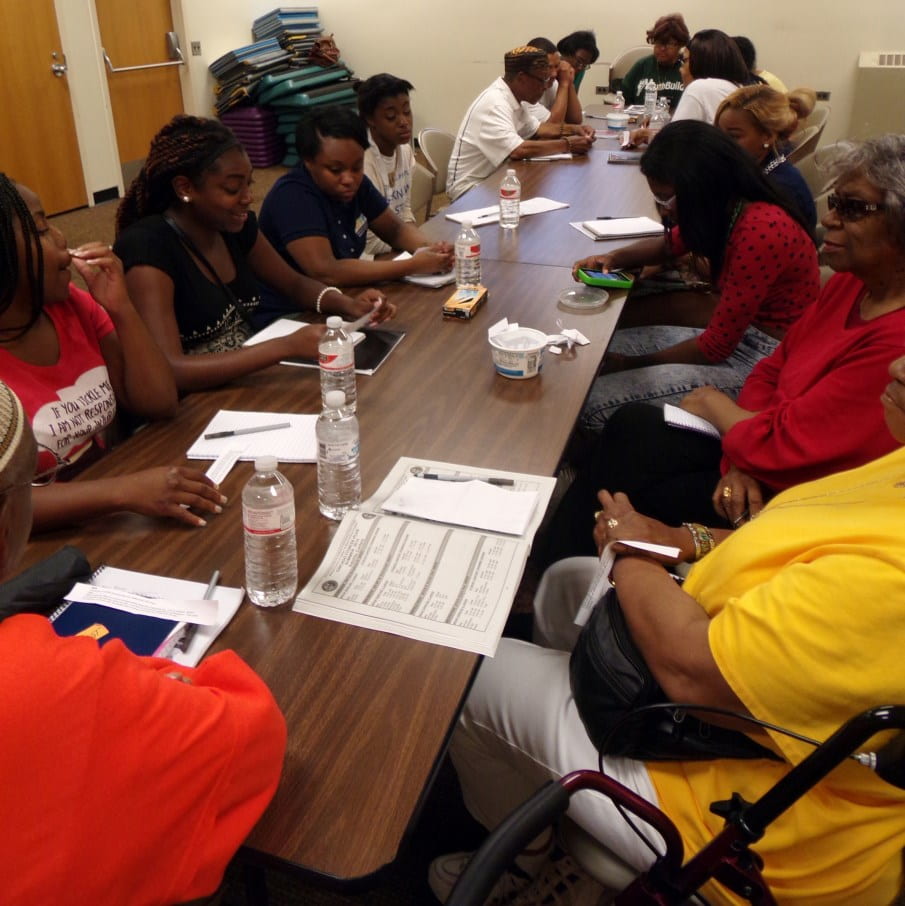Monday’s Agenda:
1. Opening Activity: 3 Elements Creative Writing
2. Debrief and feedback from practice interviews
3. Conduct Interviews
4. Closing: hand out t-shirts!
In the second week of Generations of Us, the young and older adult participants jumped right into recording their conversations. While I was preparing the curriculum, I had originally envisioned the young people interviewing the Seniors, but as the project evolved the group drifted towards recording intergenerational dialogues based on the oral history interview questions. I have encouraged the recordings to take place between 2-4 people so that the conversation can reach a certain depth that does not occur with a large group in a short amount of time. I am impressed by the conviction of the participants and their eagerness to share and listen to each other’s stories.
Today, we began with a creative writing exercise to get the storytelling juices flowing and then broke into four small groups for recording. I gave some feedback to the group after listening to their practice interviews. This feedback included not chewing or unwrapping food during the interview, passing the microphone around to each speaker, and spreading out in the room to avoid recording others’ conversations. In total, we recorded four conversations today. The topics of those conversations included pain, growing up, changes over time, and Chicago history.

Tuesday’s Agenda:
1. Opening Activity: Myths and Facts
2. Conduct Interviews
3. Closing: Presentation preparation and more t-shirts!
On Tuesday, I decided to begin the day with another intergenerational-themed activity, similar to those of the first week. I passed out bowl with slips of paper that listed myths about young and old people. The group responded really well to this activity, and enjoyed debating the impacts that some of the myths about their age brackets have on their lives. Here are examples of two myths, what do you think?
Myth
Most teenagers are lazy and don’t want to help their communities.
Fact
Six out of ten young people already volunteer with community agencies. Almost nine out of ten teenagers would volunteer to take part in programs to help prevent crime if they knew how to get involved with their communities
Myth
Older people need looking after.
Fact:
Contrary to popular stereotypes, most seniors older adults live in their own homes and enjoy a measure of independence. Many older adults compensate for these down-sides of the aging process through hobbies, travel, volunteer activities, and meaningful relationships with family and friends. Only about 5% of people 65+ actually live in nursing homes.

KODAK Digital Still Camera
After we finished our opening activity, we divided into 6 groups of 2-3 people and conducted more interviews. I am impressed by the leadership of the older adults who support and encourage the young people who are less eager to conduct an interview. I can see that the hesitant or excited young people gain confidence as they approach, begin, conduct, and complete an interview. They have begun to cultivate relationships and with those of a different generation and yet have learned a lot about the universality of the human experience. Many of the participants takeaways from the interviews include their surprise at the number of similar experiences that young and old people have had and continue to have as well as an awe of the longevity and full lives of our older adult participants. I can’t wait to share the interviews during our presentation and to hear the young and old people reflect on their experiences at the Atlas Senior Center!
